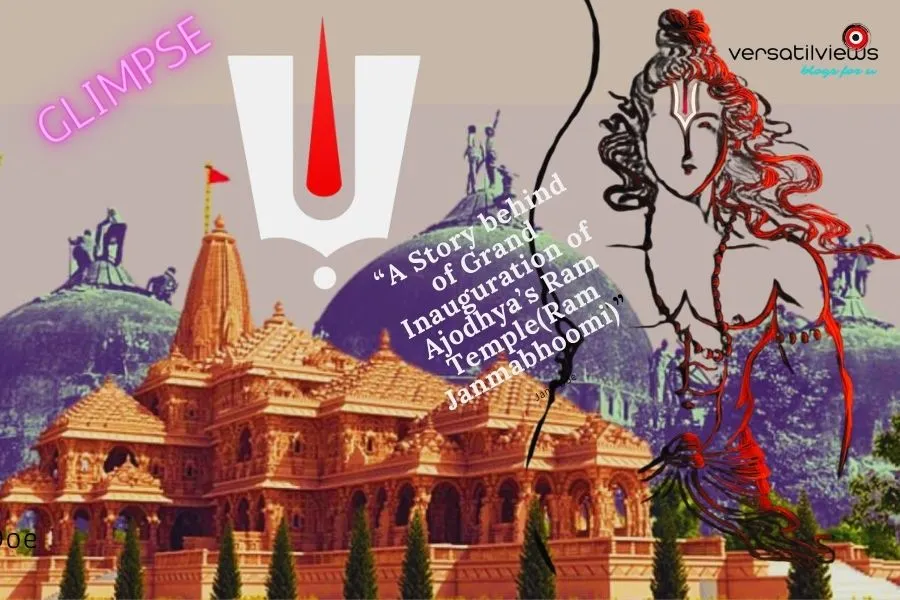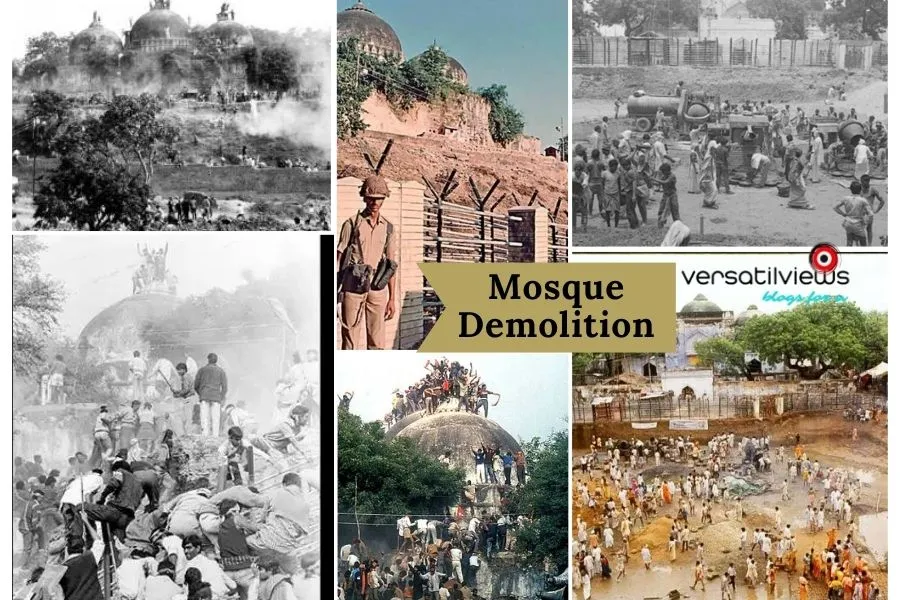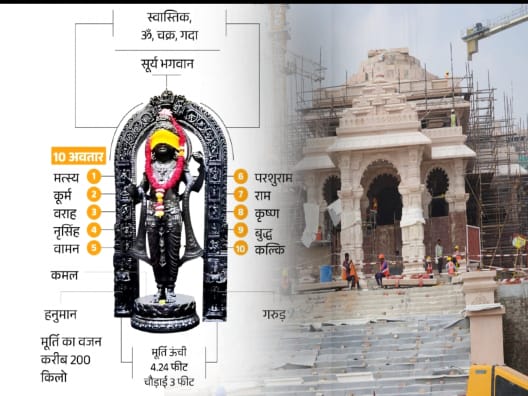The imminent inauguration of the Ram Temple in Ajodhya marks a historic moment, as the consecration (Pran Protista) of Ram Lalla is scheduled to unfold between 12:00 PM and 12:45 PM on 22nd January 2024.

simultaneously the old Idol
Ram Lala will be praised
inside the Temple
Leading the ceremony in the temple town will be Prime Minister Narendra Modi, accompanied by notable figures such as UP CM Yogi Adityanath, RSS chief Mohan Bhagwat, UP Governor Anandiben Patel, and the president of the temple trust, Mahant Nritya Gopal Das.
The grand event is expected to host over 7,000 dignitaries, including cricketers, personalities from the entertainment world, and prominent businessmen, all of whom have been extended invitations to witness this auspicious occasion

Ajodhya’s Complex Saga: Unraveling the Historical Tapestry from Ramayana to the Babri Masjid Demolition
The Ramayana, an ancient Hindu epic dating back to the 1st millennium BCE, narrates that Ajodhya was the capital of Shree Rama. Local Hindu tradition asserts that the demolished Babri Mosque site in Ajodhya is the precise birthplace of Shree Rama. Constructed during 1528–29, the mosque is attributed to ‘Mir Baqi’ (possibly Baqi Tashqandi), a commander under the Mughal emperor Babur (r. 1526–1530). Nevertheless, historical evidence supporting these claims remains sparse
The historical narrative of Ajodhya, as documented by travelers and historians, unveils layers of complexity surrounding its sacred sites. In 1611, William Finch observed Ajodhya’s ruins, notably the Ranichand castle, without mentioning a mosque. Thomas Herbert in 1634 described the Ranichand castle as an ancient monument, but by 1672, Lal Das’s Awadh-Vilasa hinted at a mosque’s presence. Jai Singh II’s 1717 acquisition of land indicated a mosque, and Jesuit missionary Joseph Tiefenthaler, in 1766-1771, claimed the Ramkot fortress’s demolition by Aurangazeb or Babur, replaced by a mosque. Francis Buchanan’s 1810 visit asserted the demolished structure was a temple, with an inscription claiming Babur’s mosque. Kishore Kunal later scrutinized and declared the mosque inscriptions as fake. Before the 1940s, the Babri Masjid was known as Masjid-i-Janmasthan. Historians like R. S. Sharma dispute Rama’s birthplace claims, proposing Ajodhya’s medieval pilgrimage development. Critics suggest Ajodhya’s Buddhist origins, challenging Hindu narratives. The Chinese pilgrim Xuanzang’s 7th-century account characterizes Ajodhya as a Buddhist site, adding layers to its historical tapestry
In 1853, armed Hindu ascetics from the Nirmohi Akhara occupied the Babri Masjid site, asserting ownership. In response, the civil administration divided the premises in 1855, allocating separate areas for Hindus and Muslims. In 1883, Hindus sought to build a temple, leading to a legal dispute dismissed by courts in 1885 and 1886, maintaining the status quo.
In December 1949, idols were placed in the mosque, claiming miraculous appearance. Despite directives from Home Minister Vallabhbhai Patel and Prime Minister Jawaharlal Nehru, the idols remained. By 1950, the state assumed control, allowing Hindu worship but not Muslim.
The 1980s witnessed the Vishva Hindu Parishad’s (VHP) campaign for the Ram Janmabhoomi Mandir at the site. In 1992,

Hindu nationalists demolished the mosque, triggering communal riots. In 2003, the Archaeological Survey of India found a 10th-century temple beneath the mosque. The Allahabad High Court upheld this in 2010.
In 2019, the Supreme Court ordered the disputed land be given to a trust for a Hindu temple and allocated 5 acres to Sunni Waqf Board for a mosque. In 2020, the Shri Ram Janmabhoomi Teerth Kshetra trust was established by the Indian government.
In 1853, armed Hindu ascetics from the Nirmohi Akhara occupied the Babri Masjid site, asserting ownership. In response, the civil administration divided the premises in 1855, allocating separate areas for Hindus and Muslims. In 1883, Hindus sought to build a temple, leading to a legal dispute dismissed by courts in 1885 and 1886, maintaining the status quo.
In December 1949, idols were placed in the mosque, claiming miraculous appearance. Despite directives from Home Minister Vallabhbhai Patel and Prime Minister Jawaharlal Nehru, the idols remained. By 1950, the state assumed control, allowing Hindu worship but not Muslim.
The 1980s witnessed the Vishva Hindu Parishad’s (VHP) campaign for the Ram Janmabhoomi Mandir at the site. In 1992, Hindu nationalists demolished the mosque, triggering communal riots. In 2003, the Archaeological Survey of India found a 10th-century temple beneath the mosque. The Allahabad High Court upheld this in 2010.

In 2019, the Supreme Court ordered the disputed land be given to a trust for a Hindu temple and allocated 5 acres to Sunni Waqf Board for a mosque. In 2020, the Shri Ram Janmabhoomi Teerth Kshetra trust was established by the Indian government.
Narrative Overview: The Evolution of Ajodhya’s Historical Landscape
Pre-18th Century: Historical Accounts and Temple Claims
- 1611 – William Finch’s Exploration: English traveler William Finch explored Ajodhya in 1611, documenting the ‘ruins of the Ranichand [Ramachand] castle and houses,’ making no mention of a mosque.
- 1634 – Thomas Herbert’s Description: By 1634, Thomas Herbert described a ‘pretty old castle of Ranichand [Ramachand],’ deeming it ‘especially memorable,’ with no reference to a mosque.
- 1672 – Awadh-Vilasa Implies Mosque Presence: In 1672, Lal Das’s Awadh-Vilasa implies the presence of a mosque at the site, describing it without referencing a castle, house, or temple.
- 1717 – Jai Singh II’s Acquisition: Mughal Rajput noble Jai Singh II acquired land around the site in 1717, documents indicating the existence of a mosque.
- 1766-1771 – Tiefenthaler’s Account: Jesuit missionary Joseph Tiefenthaler, visiting between 1766 and 1771, claimed either Aurangazeb or Babur had demolished the Ramkot fortress, replacing it with a mosque. Hindus continued prayers at a mud platform marking Rama’s birthplace.
Post-18th Century: Temple Destruction, Mosque Construction, and Controversies
- 1810 – Buchanan’s Assertion: In 1810, Francis Buchanan visited and asserted that the structure destroyed was a temple dedicated to Rama. Many subsequent sources suggest the mosque was built after demolishing a temple. Buchanan documented an inscription on the mosque’s wall claiming construction by Babur.
- 1813 – Alleged Fake Inscriptions: Police officer and writer Kishore Kunal scrutinized Buchanan’s documents, asserting that the claimed inscriptions on the Babri mosque were fake, affixed around 1813, almost 285 years after the supposed construction in 1528 CE, and later replaced multiple times.
Pre-1940s – Babri Masjid Commonly Referred to as Masjid-i-Janmasthan:
- Before the 1940s, the Babri Masjid was commonly referred to as Masjid-i-Janmasthan (‘mosque of the birthplace’) in both everyday language and official documents.
- Claims by Shykh Muhammad Azamat Ali Kakorawi Nami and H.R. Neville:
- Shykh Muhammad Azamat Ali Kakorawi Nami claimed the mosque was built in 923 A.H. under the patronage of Sayyid Musa Ashiqan in the Janmasthan temple. H.R. Neville, editor of the Faizabad District Gazetteer (1870), stated the Janmasthan temple was destroyed by Babur and replaced by a mosque in 1528 A.D.
Historical Interpretations and Controversies:
- Post-18th Century Claims Questioned: Historians, including R. S. Sharma, argue that claims regarding the Babri Masjid site as Rama’s birthplace only gained prominence after the 18th century. Ajodhya’s status as a Hindu pilgrimage site is debated.
- Buddhist Origins Proposed:Critics propose that Ajodhya originally served as a Buddhist site, aligning with its identification as Saketa in Buddhist texts. Historian Romila Thapar emphasizes the city’s earliest documented reference in the 7th century as a Buddhist site.
Post-1853: Babri Masjid Occupation and Legal Disputes
- 1853 – Nirmohi Akhara Occupation: In 1853, armed Hindu ascetics from the Nirmohi Akhara occupied the Babri Masjid site, asserting ownership.
- 1855 – Premises Division by Civil Administration: In 1855, the civil administration divided the premises, allocating separate areas for Hindus and Muslims.
- 1883 – Legal Dispute over Temple Construction: In 1883, Hindus sought to build a temple, leading to a legal dispute dismissed by courts in 1885 and 1886, maintaining the status quo.
Post-1940s: Babri Masjid Events and Legal Proceedings
- 1949 – Idols Placed and State Intervention: In December 1949, idols were placed in the mosque, claiming miraculous appearance. Despite directives, the state assumed control in 1950, allowing Hindu worship but not Muslim.
- 1980s – VHP Campaign and 1992 Demolition: In the 1980s, the Vishva Hindu Parishad (VHP) campaigned for the Ram Janmabhoomi
- 1992 – Mosque Demolition and Communal Riots: On December 6, 1992, Hindu nationalists demolished the mosque, resulting in communal riots and over 2,000 deaths.

- 2003 – ASI Excavations: In 2003, the Archaeological Survey of India (ASI) conducted court-ordered excavations, revealing a 10th-century north Indian style temple beneath the mosque.

- 2009 – BJP Manifesto: In 2009, the Bharatiya Janata Party (BJP) reiterated its promise to construct a temple to Rama at the site.
- 2010 – Allahabad High Court Ruling: In 2010, the Allahabad High Court ruled to divide the 2.77 acres of disputed land into three parts, allocating portions to Ram Lalla, Sunni Waqf Board, and Nirmohi Akhara. All parties appealed to the Supreme Court.
- 2019 – Supreme Court Verdict: A five-judge Supreme Court bench heard the title dispute cases from August to October 2019. On November 9, 2019, the Supreme Court ordered the land handed to a trust to build the Hindu temple. It also directed the government to provide an alternate 5-acre land to Sunni Waqf Board for a mosque.
- 2020 – Creation of Shri Ram Janmabhoomi Teerth Kshetra: On February 5, 2020, the government of India established the Shri Ram Janmabhoomi Teerth Kshetra trust.
If need few more details then Ram Mandir(Ram Janmabhoomi)-Babri Masjid issue: Read the entire timeline of the dispute

Conclusion

The successful completion of the Pran Pratishtha ceremony for Ram Lalla in Ajodhya stands as a watershed moment in India’s history, marking the realization of a long-standing religious aspiration amidst decades of legal battles and socio-religious tensions surrounding the Ram Janmabhoomi-Babri Masjid dispute. The ceremony’s conclusion serves as a testament to the resilience of the Indian judicial system in addressing complex and sensitive issues.
This historic event, graced by the presence of Prime Minister Narendra Modi, UP CM Yogi Adityanath, RSS chief Mohan Bhagwat, and over 7,000 dignitaries from various spheres, not only signifies the religious significance of Lord Rama but also reflects the unity and diversity of the nation. The elaborate rituals and enthusiastic participation highlight the widespread interest and importance attached to this auspicious occasion.

As the Pran Pratishtha concludes, it ushers in a new chapter in Ajodhya’s cultural landscape, fostering healing, unity, and a spirit of shared identity. This momentous step in India’s cultural heritage emphasizes the coexistence of history, tradition, and contemporary values, paving the way for a future where historical conflicts can be peacefully resolved through dialogue and legal processes, fostering collective progress and inclusivity.
nice info and well narrated..keep on writing
Jai Shree Jagannath
Somebody essentially lend a hand to make significantly posts I might state That is the very first time I frequented your web page and up to now I surprised with the research you made to create this particular put up amazing Excellent job